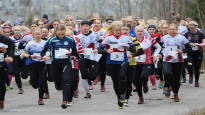The traditional Tiomila orienteering relay organized on the weekend will see a significant reform this year, as the women’s race will include two night sections for the first time.
In the past, women have competed against each other in large relays (Tiomila, Venloje’s relay) only during the day. In addition, the women’s relay will increase from a five-leg competition to six legs.
Runner of the opening leg of Tampere Pyrinnö, one of Finland’s hopes for success Lotta Karhola welcomes the reforms of the women’s message.
– It’s really great that we can get slightly bigger teams and the challenge of night orienteering in the women’s relay.
Due to the reform, the men’s and women’s relays take place one after the other, and they are both on a break for a while, while the competitors of the second relay are in the forest. Posts will be continued after the break in chases.
Towards equality
For example, in athletics and skiing, men and women compete over the same distances and in similar conditions. In orienteering, this is not yet the case, at least for large messages.
At the top event of orienteering, in the Jukola relay, men run a 7-leg night relay with varying leg lengths. The top women’s part is the four-part Venloje relay, which is contested during the day.
In recent years, top women have valued Tiomila higher than Venlo. In the summer, for example, the top of the national team Marika Teini said that he questioned the current domestic model.
– When sport has become more equal, in recent years it has started to seem funny that the women’s competition in the main event of our sport is similar to the 70s, when women’s sports were not valued at nearly the same level as men’s, Teini wrote on her Instagram account in the summer.
From Lotta Karhola, Tiomila’s night sections are a step towards equality. It is good to make reforms gradually, as many clubs would not necessarily have ten female athletes, half of whom would run at night like in the men’s relay.
– When we increase the share one by one, maybe little by little women will also remain as relay women in the sport. Then there are also more people in the women’s series who want to invest in messages, Karhola says.
– I see that this is a good direction. We get the same challenges for men and women in terms of skill.
In Karhola’s opinion, it is good that the reforms are tried out in Tiomila first, after which they can also be considered for the post of Jukola and Venloje.
Changes to the section lengths
Lotta Karhola also hopes for changes to Venloje’s message, but admits at the same time that there are no ready-made solutions for the development of Jukola’s race weekend. Masses of exercisers bring their own challenge, which is not present in Tiomila.
Women’s message about Karhola should be more varied in any case. The proportions are currently quite similar.
– There has been no tactical and role-playing perspective at all. If there were 5–6 sections, one of which was clearly longer and one clearly shorter, then Venloje’s message would have more character.
– Someone somewhere hinted that men and women should have a day race and a night race every other year. Maybe it could be the best solution somewhere in the far future.
Chairman of the Kaukametsäläinen organizing organization of the Jukola message Juhani Sihvonen says that the section lengths of Venloje’s relay are going to be changed starting next year. The change is based on a survey of about a hundred top orienteers.
– There would be one clearly longer section. The others would be the same length. This is only possible because we advance the event by half an hour, says Sihvonen.
There are no plans to make drastic changes like Tiomila’s in Finland, at least with these prospects.
Leap in the dark?
Women have never had a worse night orienteering competition before. In Finland, the most significant events have been the National Championship night held once a year and some competitions in the Messaging League.
The lack of night orienteering routines may make the start of the women’s relay unpredictable and possibly even decisive in terms of the battle for the top. Just the first two clips take place in the dark.
– In the first two sections, there can be quite big differences. In that terrain, it is possible to make big mistakes if you don’t stay on the map, says Karhola.
Karhola, who starts with a headlamp, says that he practiced night orienteering at the “Punahilkko” Spanish camp.
– There we did many joint trainings in the dark, where there were group departures and communication-like disturbances. In April-May, I’ve managed to orientate at night a couple of times.
The situation may favor Swedish clubs, which have a wider message and night orienteering culture than Finns.
Karhola mentions IFK Göteborg, who won the women’s double last year, when the talk turns to the struggle for victory. Finns, however, boldly set out to challenge their western neighbors.
– We haven’t talked about the rankings or the profit goal in more detail, but we see ourselves right there in the top fight. Let’s see what my good performances are enough for this year.
The first team of Pyrinnö, which won the women’s relay as the previous Finnish team in 2019, runs in Tiomila in the order Lotta Karhola, Enni Jalava, Venla Taulavuori, Anni Haanpää, Sail Kinni and Venla Harju.
